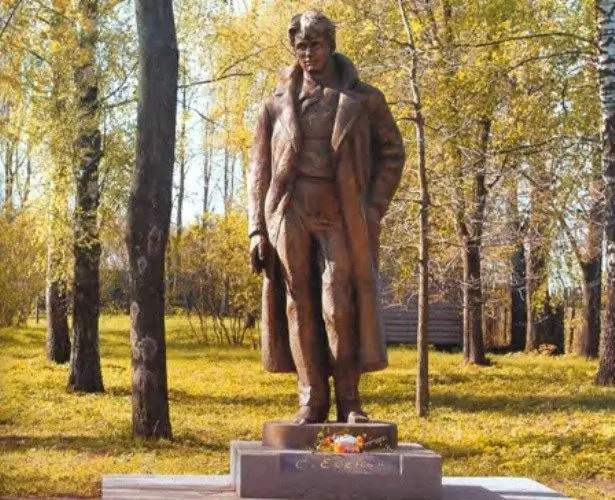- Author Antonio Harrison [email protected].
- Public 2023-12-16 07:44.
- Last modified 2025-01-22 21:44.
The refined lyrics of Sergei Yesenin continue to attract the attention of poetry lovers. The poet's deep penetration into the essence of the Russian soul and his ability to create unique landscapes are probably largely associated with his childhood and youth, which took place in the village of Konstantinovo, located not far from Ryazan.

Where was Sergei Yesenin born
The famous Russian poet was born on October 3, 1895 into a simple peasant family. It happened in the village of Konstantinovo of the former Ryazan province. Here Yesenin grew up, studied at a zemstvo school, and then at a school that trained teachers for the village. In his native village, the future poet lived a little after graduation. Only at the age of seventeen did Yesenin leave his native land, going to Moscow, where he worked in a printing house as a proofreader, continuing to work on his poems.
The village of Konstantinovo had a long history. The first mention of the settlement dates back to the beginning of the 17th century. The life of the peasants there over the centuries did not differ from the existence of other rural residents of tsarist Russia. Only with the release of the manifesto on the abolition of serfdom did the peasants receive relief, although they became finally free in fact only in 1879, when the last payments for the land were made.
Gradually, new economic relations began to be established in the village. A layer of wealthy peasants with an entrepreneurial flair was formed, who did not forget about the needs of the village and erected chapels here, bought bells for the church, built reliable and beautiful houses.
Luck smiled not at everyone. Some residents of the village had to leave their former place of residence and go to other regions in search of a better life.
In the homeland of the poet
The historical appearance of Yesenin's small homeland was formed only by the beginning of the last century. The village stretches along the Oka River for more than three kilometers. A wide street in the center of the village and the side streets adjacent to it formed a single whole. The main square of the settlement was adorned with a temple; a manor house and a zemstvo school were located nearby.
The main wealth of the inhabitants of the village is the flooded meadows adjacent to the Oka. They gave a lot of hay, part of which was sold, while the rest was used by the peasants in their households. Almost every family kept a cow, or even two.
Undoubtedly, from childhood, the future poet absorbed the peculiarities of peasant life. The beauty of the peasant soul and the richness of the colors of the Ryazan nature left an imprint not only in the memory of the poet, but also in his work. The poet's roots remained in the Russian village. That is why Yesenin was able to express in his poems an ardent love for his native land, praise its bright nature and the beauty of the soul of the Russian people.
On the occasion of the seventieth anniversary of the poet's birth, a museum and exhibition was opened in Konstantinovo, which illuminated the life and work of Sergei Yesenin. Today one of the most impressive museum complexes in Russia is located here. Museum visitors have the opportunity to plunge into the atmosphere in which the formation of the poet took place and his first poetic images were born.






